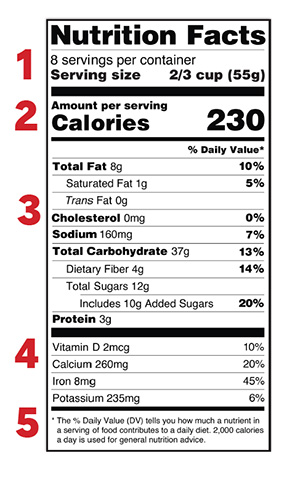Understanding Food Nutrition Labels
The Nutrition Facts label can help you make healthier eating choices and identify nutrient-dense foods for a healthy diet. Here are some tips to better understand the information on these labels.
Learn what to look for on the label.

1 - Start with the serving information.
This tells the size of a single serving and the total number of servings per container. The serving size reflects the amount people typically eat or drink.
2 - Check total calories per serving and container.
Notice how many calories are contained in one serving. Compare this to the number of servings you eat. If you eat two servings, you double the calories and nutrients.
The next sections on a Nutrition Facts label are about the amounts of specific nutrients in the product.
3 - Limit certain nutrients.
Check key nutrients and understand what you’re looking for.
- Focus on the amount of saturated and trans fats rather than the amount of total fats. Not all fats are bad.
- Avoid trans fat. When the Nutrition Facts label lists “0 g” of trans fat but includes “partially hydrogenated oil” in the ingredient list, it means the food contains some trans fat, but less than 0.5 grams per serving. So, if you eat more than one serving, you could end up eating too much trans fat.
- Total sugars include both natural and added sugars.
- Limit the amounts of added sugars, saturated fat and sodium you eat.
- Compare labels on different brands or similar products and choose foods with less of these nutrients when possible.
4 - Get enough of the beneficial nutrients.
Make sure you get enough of the nutrients your body needs, such as calcium, dietary fiber, iron, potassium and vitamin D.*
Dietary fiber may help reduce blood cholesterol levels, promote a feeling of fullness, and support healthy weight management. Adults need at least 25-34 grams of fiber daily for good health.
5 - Understand % Daily Value.
The % Daily Value (DV) tells you the percentage of each nutrient in a single serving, in terms of the daily recommended amount. If you want to consume less of a nutrient (such as saturated fat or sodium), choose foods with a lower % DV (5% or less). If you want to consume more of a nutrient (such as fiber), choose foods with a higher % DV (20% or more).
The information shown on the label is based on a diet of 2,000 calories a day. You may need less or more than 2,000 calories depending upon your age, gender, activity level and whether you’re trying to lose, gain or maintain your weight.






